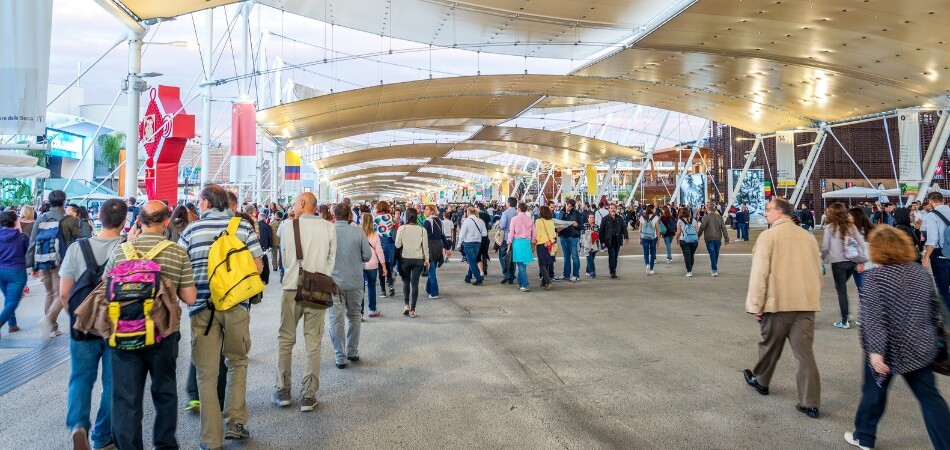An exhibition serves as a vital platform for artists, innovators, and visionaries to showcase their work to the public. However, one question that often arises in the planning process is, “How Long Should an Exhibition Last?” The duration can significantly impact the effectiveness and success of the exhibition.
A well-timed event can maximize engagement, provide ample opportunity for interaction, and foster a deeper appreciation of the showcased works. Conversely, an overly prolonged exhibition might lead to a dip in interest and attendance. Various factors such as the nature of the exhibit, the attention span of the audience, logistical considerations, and the overarching goals of the exhibition must be meticulously evaluated to determine the ideal duration.
Hence, planning the length of an exhibition requires a balanced approach to ensure it achieves its intended objectives while keeping the audience captivated. This blog dives deep into these determinants, offering insights to help you gauge the optimal duration for any exhibit, ensuring it receives the attention and appreciation it truly deserves.
Expo Exhibition – A Quick Overview
The world of exhibitions has always been a hive of activity where creativity meets commerce. These events are a testament to human ingenuity and ambition, from business expos to art displays. Dive into a quick overview of the Expo Exhibition.

Expo exhibitions serve as global platforms, bringing together ideas, innovations, and cultures worldwide. Showcasing the best of the best, they provide unique opportunities for industries and nations to interact. These events, Spanning weeks or months, attract millions, offering insights, entertainment, and potential collaborations.
In recent times, digital transformations have reshaped these gatherings. Virtual expos have gained traction, ensuring global participation irrespective of geographical constraints. Regardless of the format, expo exhibitions continue to inspire, educate, and connect humanity in unprecedented ways.
Different Types of Exhibitions at an Expo
Expo exhibitions are diverse arenas that cover a broad spectrum of industries and themes. Depending on their objectives and participants, these events take on various forms.
Here’s a glimpse into the myriad types of exhibitions held at an expo:
Trade Exhibitions:
Trade exhibitions focus exclusively on business-to-business interactions. Companies showcase their latest products, services, and technological advancements. These events facilitate networking and foster potential business collaborations.
Consumer Exhibitions:
Targeted primarily at the general public, consumer exhibitions present products and services for purchase. They’re platforms for brands to interact directly with their end-users. Attendees get firsthand experience of the showcased offerings.
Artistic Exhibitions:
Art expos celebrate creativity, showcasing works from emerging and established artists. Visitors immerse themselves in visual art, sculptures, installations, and other forms. It’s a convergence of culture, expression, and inspiration.
Educational Exhibitions:
These expos emphasize knowledge-sharing and learning. Universities, institutions, and educational tech firms display their programs and innovations. Attendees gain insights into academic advancements and future learning trends.
Virtual Exhibitions:
With technological evolution, exhibitions have ventured online. Virtual expos connect global audiences without geographical barriers. They offer immersive experiences using advanced digital tools and platforms.
Thematic Exhibitions:
Organized around a specific theme or subject, these exhibitions offer deep dives into particular topics. From environmental conservation to historical retrospectives, they provide comprehensive insights and often advocate for change. Attendees leave with enriched understanding and heightened awareness.
Cultural Exhibitions:
Highlighting the rich tapestry of world cultures, these expos celebrate diversity. They showcase traditional arts, crafts, performances, and culinary delights from different regions. Such events foster cross-cultural appreciation and understanding.
Innovation and Tech Exhibitions:
Tech expos are the hotspots for unveiling cutting-edge innovations. Companies and startups introduce their latest inventions, from AI-driven tools to breakthrough medical devices. It’s a glimpse into the future of technology and its societal implications.
Interactive Exhibitions:
Prioritizing visitor engagement, these expos encourage hands-on experiences. Interactive booths, games, and simulations make learning and exploration fun. They’re particularly popular among younger attendees, blending education with entertainment.
Each type of exhibition serves a unique purpose, catering to varied interests and objectives. As expos continue to evolve, they remain crucial platforms for sharing, learning, and collaborating on a global scale.
How Long Should an Exhibition Last?
The duration of an exhibition often sparks intriguing debates among curators and exhibitors. Factors influencing its length are multifaceted and require careful consideration. Delve into the complexities of determining how long an exhibition should last.

A well-received exhibition might warrant an extended showcase. If visitors flock in droves and feedback is positive, extending its duration can be beneficial. High demand ensures continued interest and engagement.
Space availability in venues plays a crucial role in dictating exhibition length. Museums or galleries might have back-to-back bookings, limiting extensions. Efficient planning ensures optimal duration without compromising subsequent events.
Some exhibitions, like those commemorating specific events, might have fixed durations. Others, focusing on current trends or seasonal themes, might be shorter-lived. Understanding the exhibition’s core objective aids in setting its length aptly.
Factors Influencing the Duration of an Expo Exhibition
Expo exhibitions, being vast and varied, are influenced by multiple factors when determining their duration. Curators and organizers weigh several elements before finalizing timelines.
Here’s a deep dive into the elements shaping the length of an expo exhibition:
Audience Engagement:
High visitor turnout and engagement can extend an exhibition’s lifespan. Positive feedback and strong visitor numbers indicate relevance and interest. Consequently, a bustling event might see a prolonged showcase.
Venue Availability:
Not all venues offer flexibility in terms of dates. Prior bookings or planned renovations impact the available window. Organizers must synchronize with venue schedules for a seamless exhibition experience.
Exhibitor Preferences:
Sometimes, the exhibitors themselves have tight schedules. Touring exhibits or those with multiple destinations require strict adherence to timelines. This factor significantly dictates the event’s duration.
Budgetary Constraints:
Organizing and maintaining an exhibition isn’t cheap. Financial limitations might restrict the length of some events. Striking a balance between costs and duration becomes crucial for success.
Trend and Relevance:
Topical or trend-based exhibitions might have shorter runs. Their relevance could diminish quickly, making prolonged displays redundant. Swiftly changing trends necessitate adaptive scheduling.
Security and Maintenance:
Preserving the integrity of exhibits, especially valuable or delicate ones, demands regular maintenance. Ensuring security for high-value items can also impact the event’s length. Continuous upkeep might shorten an exhibition’s duration.
Each influencing factor brings its own set of challenges and opportunities. Striking the right balance ensures that expo exhibitions are both impactful and efficient in their delivery.
Tips to Get the Most out of an Expo Exhibition
Navigating an expo exhibition can be overwhelming, given the myriad of displays and activities. To maximize the experience, planning and strategizing become crucial.

Here are some effective tips to extract the best out of any expo exhibition:
- Early Arrivals: Arriving early helps avoid massive crowds. This ensures a relaxed exploration, letting you interact freely with exhibitors.
- Plan Ahead: Research exhibits and prioritize your interests. With a mapped-out itinerary, you’ll efficiently cover your targeted areas.
- Engage Actively: Engaging with exhibitors offers deeper insights. Ask questions, attend demonstrations, and absorb as much knowledge as possible.
- Take Notes: Jotting down key points can aid recall later. Capture both intriguing ideas and potential collaboration opportunities for future reference.
- Network Smartly: Expos are networking goldmines. Prioritize quality conversations over quantity, focusing on building lasting professional relationships.
- Dress Comfortably: Comfortable attire, especially footwear, ensures easy navigation. With long hours on foot, you’ll appreciate this consideration immensely.
- Revisit Key Stalls: Double-backing to significant stalls reinforces relationships. It also provides a second chance to clarify doubts or gather missed information.
- Leverage Technology: Use event apps or digital guides, if available. They often provide real-time updates, maps, and scheduling tools for enhanced convenience.
Final Thoughts
Navigating the multifaceted world of expo exhibitions presents challenges and opportunities. While the buzz around “How long should an exhibition last?” remains a pivotal question, the answer lies within a matrix of influencing factors.
From gauging audience engagement to assessing venue availability and weighing in on the content’s relevance, the optimal duration is rarely static. Beyond the period, attendees and exhibitors must employ strategies to ensure a meaningful and enriching experience.
As the landscape of exhibitions continues to evolve, especially with digital transformations, the essence remains: exhibitions are platforms for discovery, learning, and connection, irrespective of their length.


